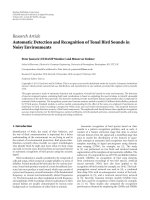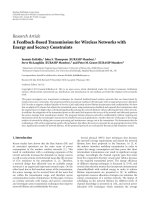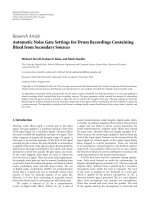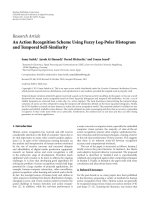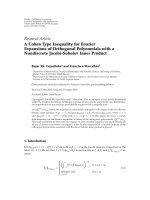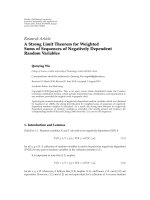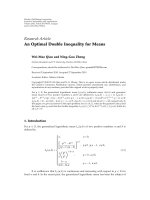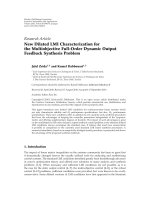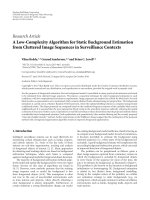báo cáo hóa học:" Research Article Automatic Speech Recognition Systems for the Evaluation of Voice and Speech Disorders in Head and Neck Cancer" pdf
Bạn đang xem bản rút gọn của tài liệu. Xem và tải ngay bản đầy đủ của tài liệu tại đây (591.95 KB, 7 trang )
Hindawi Publishing Corporation
EURASIP Journal on Audio, Speech, and Music Processing
Volume 2010, Article ID 926951, 7 pages
doi:10.1155/2010/926951
Research Article
Automatic Speech Recognition Systems for the Evaluation of
Voice and Speech Disorders in Head and Neck Cancer
Andreas Maier,
1
Tino Haderlein,
1
Florian Stelzle,
2
Elmar N
¨
oth,
3
Emeka Nkenke,
2
Frank Rosanowski,
1
Anne Sch
¨
utzenberger,
1
and Maria Schuster
1
1
Division of Phoniatrics and Pediatric Audiology, Erlangen University Hospital, Friedrich-Alexander University Erlangen-Nuremberg,
Bohlenplatz 21, 91054 Erlangen, Germany
2
Department of Maxillofacial Surgery, Erlangen University Hospital, Friedrich-Alexander University Erlangen-Nuremberg,
Gl
¨
uckstraße 11, 91054 Erlangen, Germany
3
Department of Computer Science, Friedrich-Alexander University Erlangen-Nuremberg,
Martensstraße 3, 91058 Erlangen, Germany
Correspondence should be addressed to Andreas Maier,
Received 6 November 2008; Revised 9 April 2009; Accepted 16 June 2009
Academic Editor: Georg Stemmer
In patients suffering from head and neck cancer, speech intelligibility is often restricted. For assessment and outcome
measurements, automatic speech recognition systems have previously been shown to be appropriate for objective and quick
evaluation of intelligibility. In this study we investigate the applicability of the method to speech disorders caused by head and neck
cancer. Intelligibility was quantified by speech recognition on recordings of a standard text read by 41 German laryngectomized
patients with cancer of the larynx or hypopharynx and 49 German patients who had suffered from oral cancer. The speech
recognition provides the percentage of correctly recognized words of a sequence, that is, the word recognition rate. Automatic
evaluation was compared to perceptual ratings by a panel of experts and to an age-matched control group. Both patient groups
showed significantly lower word recognition rates than the control group. Automatic speech recognition yielded word recognition
rates which complied with experts’ evaluation of intelligibility on a significant level. Automatic speech recognition serves as a good
means with low effort to objectify and quantify the most important aspect of pathologic speech—the intelligibility. The system
was successfully applied to voice and speech disorders.
Copyright © 2010 Andreas Maier et al. This is an open access article distributed under the Creative Commons Attribution License,
which permits unrestricted use, distribution, and reproduction in any medium, provided the original work is properly cited.
1. Introduction
Head and neck cancer may affect speech and voice. In many
cases, surgical treatment will even deteriorate the patients’
ability for oral communication and thus affect their quality
of life [1]. So, rehabilitation of dysglossia and/or dysphonia
is of outstanding clinical interest. However, assessment of
these functional features often lacks objectivity, as it is mainly
performed by expert rating which is time- and manpower-
consuming and—although being the gold standard in the
clinical field—questionable for scientific purpose. Even
speech pathologists with high expertise reach only low
reliability when judging disturbed speech [2]. Therefore,
a panel of several listeners may be used for evaluation of
speech disorders and temporal structure of speech [3]. Of
course, this makes assessment even more time-consuming,
“expensive,” and inadequate for clinical application. So, there
is need for automatic evaluation of speech and voice.
However, objective assessment of speech disorders and
severe voice disorders are neither nationally nor internation-
ally standardized [4]. For a long time, automatic diagnostic
tools for quantitative assessment of speech and voice are
restricted to single aspects such as the quantification of
nasalance in text passages, spectral characteristics, and inten-
sity of the voice signal in sustained vowels [5]. Moreover,
most commonly used methods have limitations for severely
disordered voice or speech and do not allow for assessing
speech intelligibility in a comprehensive and reliable way.
The use of speech processing methods for speech intel-
ligibility assessment is getting more and more popular [6].
2 EURASIP Journal on Audio, Speech, and Music Processing
Van Nuffelen et al. presented an automatic measure for
the phoneme intelligibility using phonological features in
dysarthric Dutch speech [7]. As perceptual reference the
Dutch Intelligibility Assessment (DIA) was applied to the
speech data to measure the phoneme intelligibility. In the
dysarthric speech data, they obtain correlations between the
perceptual evaluation and their automatic measure of up
to 0.94. By now the procedure was also extended to be
applicable to other types of disorders [8].
Visualization of speech and voice disorders helps the
medical staff in the assessment of voice and speech dis-
orders. The Sammon transform is suitable to reduce the
dimensionality of the speech data to create a map which
allows the comparison between different speakers [9]. Also
the influence of the recording conditions can be reduced
efficiently [10].
In this study, we describe a new automatic method for
the evaluation of speech intelligibility in comparison to
traditional perceptual evaluation. The new method is based
on automatic speech recognition techniques and was tested
on speech of patients with different but significant extents of
speech disorder (dysglossia) and voice disorder (dysphonia)
after the treatment for head and neck cancer.
2. Speech Disorders in Patients with
Oral Cancer
Dysglossia often occurs in patients with oral squamous cell
carcinoma which belongs to the ten most frequent malignant
diseases [11]. The extent of dysglossia depends on many
factors such as the stage of the tumour, its localisation, but
also on the individual treatment procedure.
The main feature in speech of patients with oral cancer
is compensatory articulation [12]. Often the movement
capability of the tongue is restricted. Hence, the patients have
to compensate this by alternative speech gestures. While the
primary voice signal, that is, the fundamental frequency, is
in a normal range, the formants and their range may be
affected. Sumita et al. showed that the first formant (F1) is
higher in the vowel /i/, and the second formant (F2) is lower
in vowels /a/, /e/, /i/, /o/, and /u/ compared to a control group
[13]. The range of F2 was also shown to be significantly lower
in patients with oral cancer.
Hence, the speech impairment basically consists of
reduced articulation skills affecting not only consonants and
consonantclusters[14], but also vowels [13]. This leads to
reduced intelligibility.
3. Voice Disorders in Laryngectomees
For the evaluation of extensive voice disorders, we chose a
group of patients with severe dysphonia after total larynge-
tomy due to laryngeal or hypopharyngeal cancer. All patients
used tracheo-esophageal substitute voice, which is regarded
as the state of the art for voice rehabilitation [14]. After
removal of the larynx, the breathing ability is maintained by
a hole in the neck. A one-way shunt valve is placed between
the trachea and the oesophagus. Then the patient can create
an artificial substitute voice by breathing in and closing the
hole in the neck. When the patient breathes out, the air will
be detoured through the one-way valve and stream from the
trachea into the oesophagus. The tissue in the oesophagus
will start to oscillate and create the so-called substitute voice.
Although the substitute voice resembles laryngeal voice
production more than alternative techniques [15], it still
shows considerable differences to laryngeal voices. It is char-
acterized by high perturbation causing roughness of the voice
and reduced prosody. It shows low fundamental frequency,
short maximum phonation time, and a different ratio of
voiced to voiceless phonation in comparison with normal
speech. All these aspects lead to significantly decreased
intelligibility.
Hence, in both disorders, intelligibility is the superordi-
nate functional outcome parameter, and so, the present study
focuses on this essential feature.
4. Speech Data
All patients and control subjects read the text “Der Nordwind
und die Sonne,” a tale from Aesop known as “The North
Wind and the Sun” in the Anglo-American world. It is a
phonetically rich text with 108 words (71 disjunctive) often
used in speech assessment in German-speaking countries. It
is also used as reference text for the International Phonetic
Alphabet by the International Phonetic Association (IPA).
The text was divided into 10 sequences (11
± 2.4words
each), according to syntactic boundaries, and shown on a
computer screen. The speech samples were recorded with
a close-talk microphone (Call4U Comfort Headset, DNT
GmbH, Dietzenbach, Germany; sampling frequency 16 kHz,
amplitude resolution 16 bit).
The dysglossia study cohort (OC) comprised 49 patients
(14 females and 35 males) after treatment of oral squamous
cell carcinoma, graded T1 to T4. The patients’ mean age was
60.1
±10.4 years. The treatment included the excision of the
tumour and additional radiotherapy for most of the patient
except for T1 grading. Recording was performed at least 3
months after the treatment had been completed.
The dysphonia patient group (LE) consisted of 39-male
and 2-female laryngectomees. Their average age was 62.0
±
7.7 years. They had undergone total laryngectomy because of
T3 or T4 laryngeal or hypopharyngeal cancer at least one year
prior to the investigation and were provided with a Provox
shunt valve for tracheo-esophageal substitute speech.
At the time of the investigation, none of the patients
suffered from recurrent tumour growth or metastases. All
patients had been informed about the scientific character of
the study and had given their informed consent.
From each patient acoustic data were recorded during
regular out patient care. All patients were native German
speakers using the same local dialect.
40 subjects (10 females and 30 males) without oral or
laryngeal diseases or malignoma of any kind speaking the
same local dialect formed the control group (CON). The
control group was age matched (58.1
± 13.3yearsold)with
respect to the patient groups.
EURASIP Journal on Audio, Speech, and Music Processing 3
5. Perceptual Evaluation
A panel of voice professionals perceptually evaluated the
intelligibility of each patient while listening to a play back of
the recordings. A five-point Likert scale was applied to rate
the intelligibility of all individual samples (1
= “very high,”
2
=“rather high,” 3 = “medium,” 4 = “rather low,” 5 =“very
low”). For the LE group, five raters were asked to use the
total range from 1 to 5 and to set 1 for “very good substitute
speech” instead of “very good normal speech.” For the four
raters of the OC patients there was no need to alter the Likert
scale.
For both databases the mean score of all perceptual
evaluations was computed for each patient. This expert mean
score was used to represent the patient’s speech intelligibility.
6. Automatic Speech Recognition System
For objective measurement, an automatic speech recog-
nition (ASR) system was applied. We use an automatic
speech recognition system based on Hidden Markov Models
(HMMs). The word recognition system was developed at the
Chair of Pattern Recognition at the University of Erlangen-
Nuremberg. In this study, the version as described in detail
by Stemmer [16] was used. A commercial version of this
ASR system is used for conversational dialogue systems
( />As features we use 11 Mel-Frequency Cepstrum Coef-
ficients (MFCCs) and the energy of the signal plus their
first derivatives. The short-time analysis applies a Hamming
window with a length of 16 milliseconds. The frame rate is
100 Hz. The filter bank for the Mel-spectrum consists of 25
triangular filters. Delta coefficients of the 12 static features
are computed over a context of 2 time frames to the left and
to the right side (56 milliseconds in total).
Our recognition system works polyphone based on
the acoustic level, that is, the acoustic attributes of a
phoneme are computed with respect to the coarticulatory
modulation caused by its phonetic context, for example, the
pronunciation of “i” in “bird” is different than the “o” in
“worth” although both realize the same phoneme /3:/. The
pronunciation depends on the phonetic context. Sometimes
this includes more than only the neighbouring phonemes.
The construction of polyphones is data driven according to
the number of observed phoneme sequences in the training
set, that is, if a context appears more than 50 times in the
training data then a polyphone is constructed. The HMMs
for the polyphones have three to four states.
An ASR system normally has a so-called bi- or tri-
gram language model. For our purpose we used several
language models to investigate the dependency between the
recognition performance and the correlation to the experts’
perceptual evaluation. With the ASR system, we calculated
the word recognition rate (WR) of the recordings [17]:
WR
[
%
]
=
C
R
∗100%. (1)
C is the number of correctly recognized words, and R is the
number of words in the reference.
Table 1: Effect of the n-gram language model on the oral
cancer (OC) data: with growing context of the language model
the recognition rate increases. Correlation ρ to the perceptual
evaluation, however, decreases if the context is too large (starting
with n
= 3 here). Higher n-grams showed even worse performance.
ρ 0-gram 1-gram 2-gram 3-gram
Correlation −0.88 −0.90 −0.90 −0.85
WR in % 44.4 50.0 67.3 74.8
The basic training sets for our recognizer are dialogues
from the Verbmobil project [18]. The topic of the recordings
is appointment scheduling of normal speakers. The data were
recorded with a close-talk microphone with 16 kHz sampling
frequency and 16 bit resolution. The speakers were from
all over Germany and thus covered most dialect regions.
However, they were asked to speak standard German. About
80% of the 578 training speakers (304 males, 274 females)
were between 20 and 29 years old; less than 10% were over
40. This is important in view of the test data, because the fact
that the average age of our test speakers was more than 60
years may influence the recognition results.
A subset of the German Verbmobil data was used for the
training set (11,714 utterances, 257,810 words, 27 hours of
speech) and 48 utterances (1042 words) for the validation
set (the training and validation corpora were the same as in
[16]).
This ASR system is integrated into the “Program for the
Evaluation and Analysis of all Kinds of Speech disorders”
(PEAKS) which can be used via the Internet [19]. Results are
available shortly after the recordings. The actual processing
speed is faster than real time. All data is transmitted
encrypted in order to guarantee the security of the data.
Furthermore, the patient data are pseudonymized. Hence,
even if the encryption was broken, no personal information
could be obtained by nonauthorized persons.
Statistical analysis was performed using SPSS [20]. For
the agreement computations between different raters on the
one hand, and raters/speech recognition system on the other
hand, Spearman’s correlation coefficient was used. Contrary
to other agreement measurements, such as Kappa and Alpha,
correlations are suitable to compare the averaged scores of
the raters and the WR even though both scales differ in
their order of magnitude. Comparisons of the mean values
were performed using Student’s T-test. The test for normal
distribution of an input variable was performed using the
Kolmogorov-Smirnov test.
7. Results
The recordings showed a wide range in intelligibility. The
perceptual evaluation resulted in 2.9
±1.0 for the oral cancer
group on the five-point scale and 2.5
± 1.0 for the group of
laryngectomees.
The effect of the language model is investigated in
Ta ble 1 using the OC data. With growing n-gram context,
the recognition rate increases (cf. Figure 1). However, the
increased n-gram context is not always beneficial for the
4 EURASIP Journal on Audio, Speech, and Music Processing
WR
0
10
20
30
40
50
60
70
80
0-gram 1-gram 2-gram 3-gram
Figure 1: Effect of the language model context on the recognition
rate: with growing context the recognition rate increases (OC data).
Correlation (|ρ|)
0.74
0.76
0.78
0.8
0.82
0.84
0.86
0.88
0.9
0.92
0-gram 1-gram 2-gram 3-gram
Figure 2: Effect of the language model context on the correlation to
the perceptual evaluation: if the language model context is increased
too much, the absolute value of the correlation to the perceptual
evaluation decreases (here starting at n
= 3). Higher n-gram
contexts showed even worse performance.
correlation to the perceptual evaluation. Figure 2 shows this
effect. While the correlations when using zero- to bigram
language models lie in the same range, the correlation
using the trigram model is reduced. With higher n-gram
context, even more severe reductions were observed. Hence,
we decided for a unigram language model in the following
experiments.
Ta ble 2 shows the results of the automatic speech recog-
nition system. In both patient groups, a high variance in the
ASR results was found. In the group with oral cancer (OC),
WR (49
± 19) differs significantly from the control group’s
WR (P<.001) with 76
±7%. Also compared to the LE group
(48
±14), the recognition results were significantly higher in
the control group (P<.001).
Inter-rater correlations were computed for each of the
raters using the respective other raters as reference, that is,
the mean of the four other raters for the LE group and the
three other raters for the OC group. For the comparison
between the automatic speech recognition system and the
expert ratings, the mean rating of all human raters was taken
Table 2: Results of the automatic recognition of the speech
recordings: the table presents the percentage of correctly recognized
words of a sequence (WR) read by laryngectomees (LE), patients
with oral cancer (OC) and a control group (CON).
WR min.;
max. in %
WR mean ±standard
deviationin%
OC
8; 82 50
± 19
LE
17; 74 48
± 14
CON
60; 91 76
± 7
Table 3: Spearman’s rank correlations ρ of each individual rater
versus the mean value of the other raters and the mean of the raters
versus the speech recognition system. The correlation is negative
for the latter because the scales for the evaluations are in opposite
directions.
OC LE
rater 1 0.84 0.82
rater 2 0.76 0.84
rater 3 0.88 0.77
rater 4 0.82 0.83
rater 5 — 0.77
WR
−0.90 −0.83
into account. Ta b le 3 shows the results of the correlation
analysis. The inter-rater correlations of the experts’ ratings
range from 0.76 to 0.88. The correlations between the
automatic system and the experts’ ratings are negative since a
high expert rating represents a low intelligibility and hence a
low recognition rate and vice versa. The agreement between
WR and the mean scores of the perceptual ratings is very
high in both patient groups and is in the same range as the
best human experts with
−0.83 and −0.90, respectively. The
experts’ ratings differ, compared to the automatic rating, less
than one point with respect to the regression line (see Figures
3 and 4).
8. Discussion
During and after therapy of malignant diseases of the head
and neck, communication skills are of special interest. Until
now, no objective method with low effort and costs existed
to determine speech and voice outcome. Here, we present
a new automatic objective measurement of speech quality
based on automatic speech recognition (ASR). It quantifies
speech intelligibility as good as the former clinical standard
procedure. According to common recommendations for
diagnostics of voice and speech disorders [5], the voice and
speech function can now be objectified and quantified. The
new method might close the gap between the exact descrip-
tion of morphologic impairment by endoscopic and imaging
methods and the standardized perceptual evaluation of the
individual handicap. ASR will enable precise evaluations of
speech and voice as a precondition for scientific purposes, for
example, for outcome measurements. It will help to specify
the influence of therapy options such as different surgical
procedures and nonsurgical therapies on communication
EURASIP Journal on Audio, Speech, and Music Processing 5
skills [21] and the role of speech and voice on the patients’
experiences [22].
For the perceptual quantitative assessment, two different
kinds of scales are widely used [23]: equal-appearing interval
scales and direct magnitude estimation scales. In recent
literature it has been discussed which type of scale is more
suitable for perceptual assessment. Some authors decide for
direct magnitude estimation scales such as visual analogue
scales, because the interval size of an equal-appearing inter-
val scale might be not equal in all continua. Hence, statistical
analyses which do not take this fact into account might
be problematic. We still decided in favour of the equal-
appearing interval scale for the sake of comparability with
earlier results of our group. Hence, for statistical analyses
one has to keep in mind that the equal-appearing intervals
might not be equal. Therefore, also distances and errors
which are usually optimized in such regression problems
in a least-square error sense might not be equal. Hence,
the Spearman rank order correlation [20] is appropriate.
It is based on the idea that the input data might not be
equally partitioned. Thus, the distances between the data
points are declared meaningless. Instead, their rank, that
is, their sequence, is considered to hold the important
information. In this manner also equal-appearing scales such
as Likert scales are reliably examined in a statistical regression
analysis. Other agreement measures, for example, Cohen’s
Kappa or Alpha, were not used in this work since they
are only applicable if all scales are defined in the same
margin.
The limitations of perceptual speech evaluation by
experts are seen when the results of the different experts,
given in Ta ble 3, are compared to each other. Although
the experts’ evaluations show a good correlation, their
mean scores vary considerably between different expert
listeners [24]. Previous studies even yielded more variability
for linear ratings of laryngectomees’ speech [25]. These
findings support the need for objective and automatic speech
evaluation.
We examined speech samples from laryngectomized
speakers and patients after treatment for oral cancer. As a
precondition for the evaluation of the patient groups, the
extent of disorder is widespread, as seen by the results of the
perceptual assessment and the ASR results. The presented
method might also be applicable to all kinds of patient
groups with other voice, speech, and language disorder, such
as dysarthria and aphasia, since the subordinate parameter
of speech—its intelligibility—is evaluated with the method
[26]. Investigation of these disorders seems to be beneficial
in the future. Even analysis of the emotional state of a patient
is within the reach of ASR methods [27].However,thisisnot
the scope of the present work.
Today, ASR is used in many domains [28]: for profes-
sional and private use as dictating machines, in call centres
when a restricted vocabulary, and “normal” voice quality
and speech without background noise can be expected, and
in the support of handicapped persons. Normally, ASR is
meant to recognize speech as good as possible, and the
technique that analyses speech signals and calculates the
most probable word sequence is more and more refined. We
Intelligibility
0
0.5
1
1.5
2
2.5
3
3.5
4
4.5
5
WR
0 20 40 60 80 100
Oral cancer
Linear (oral cancer)
Figure 3: Comparison between the automatic evaluation, that is,
the word recognition rate (WR) and the perceptual intelligibility
evaluation by 5 expert listeners on the dysphonia (LE) database (ρ
=
−
0.83).
Intelligibility
0
0.5
1
1.5
2
2.5
3
3.5
4
4.5
5
WR
0 20 40 60 80 100
Laryngectomees
Linear (laryngectomees)
Figure 4: Comparison between the automatic evaluation, that is,
the word recognition rate (WR) and the perceptual intelligibility
evaluation by 4 expert listeners on the dysglossia (OC) database
(ρ
=−0.90).
6 EURASIP Journal on Audio, Speech, and Music Processing
use the technique for diagnostics to quantify the influence
of altered speech and voice on the recognition results in
stable ASR conditions. The quality of the recognition allows
assessing the quality of the speech signal. In order to
exclude methodical interferences, a standard text and a stable
recording setup are used. Thus, the speaker remains the only
factor of influence.
For this study, we applied a nonadapted ASR system
for automatic speech evaluation that has previously been
proven to be adequate for “normal” speech samples [16]. The
automatic speech evaluations were compared to a control
group of 40 speakers without speech pathology in this study.
As increased age has been shown to have a negative influence
on automatic speech recognition [29], the control group
consisted of speakers of similar age compared to the patient
groups. In our study, control speakers reached a word recog-
nition rate of 76
± 7% on average. This result might seem
relatively low compared to other applications of ASR. Here
it is caused by the use of a unigram language model which
excludes semantic or contextual information. Therewith, the
speech recognition is mostly based on acoustic properties
of the words. Further use of linguistic knowledge indeed
improves the recognition rate of the system as shown with
the OC data, but the improvement by language modelling
diminishes the impact of articulation and voice on the
WR. In order to compare the perceptual evaluation with
the automatic one, the differences in the recognition rates
are more important than the absolute values, that is, the
recognition rate does not need to be 100% as shown on the
OC data (cf. Figure 2).
The result of our procedure is the percentage of correctly
recognized words of a sequence—the word recognition rate.
It is robust to reading errors. If a reader repeats or corrects
himself, only the correct word is regarded for the evaluation
since the system ignores additional wrong words. Hence,
a low WR represents a reduced percentage of correctly
recognized words. This corresponds to the perception by
a human listener and, therefore, reflects the definition of
intelligibility.
Until now, the technique has only been tested for the
German language but might also be appropriate for other
languages. A transfer to other speech or voice disorders
is possible and has yet been shown for children’s speech
[30]. For clinical purpose the technique is embedded into a
recording and evaluation software that can be easily accessed
via the Internet on any PC provided with a microphone and
asoundcard[17]. The computation of the WR is quickly
performed in less than real time, this is what makes the
method a time- and manpower-saving procedure. Hence, the
method is suitable for everyday clinical use.
We prefer ASR over other speech evaluation techniques
based on forced alignment (FA) which is often used in second
language learning. FA would allow only for one reference
speaker. In this case it would be unclear who would be the
best reference speaker. It is also unclear how FA should deal
with self-corrections of the speaker. This would be regarded
as an error in the FA. Of course, one could use all control
speakers and their variations for the FA and compute some
kind of mean score. However, this would be computationally
much more expensive. The proposed method is supposed to
work in real time.
The results of the control group demonstrated that the
standard deviation in WR of “normal” speech in speakers
of the same age is about half of the pathologic one. This
is still considerable. Currently, norm data for all age classes
and gender are not available. These could quantify a patient’s
intelligibility in relation to the norm in percent ranks. In the
future, by using a larger control group, we will be able to
provide age- and gender-dependent values for the WR. Then
the deviation from normal speech will even be quantified
exactly for each patient.
For the clinician, our novel method will allow an easy-
to-apply, automated observer-independent evaluation of all
kinds of voice and speech disorders in less than real time via
the Internet.
9. Conclusion
Speech evaluation by an automatic speech recognition sys-
tem is a valuable means for research and clinical purpose in
order to determine the global functional outcome of speech
and voice after the treatment of head and neck cancer. It
allows quantifying the intelligibility also in severely disturbed
voices and speech.
Acknowledgments
This work was supported by the Deutsche Krebshilfe (Grant
no. 106266) and the ELAN-Fonds of the University Erlangen-
Nuremberg. The authors are responsible for the content of
this article.
References
[1] N C. Gellrich, R. Schimming, A. Schramm, D. Schmalohr,
A. Bremerich, and J. Kugler, “Pain, function, and psychologic
outcome before, during, and after intraoral tumor resection,”
Journal of Oral and Maxillofacial Surgery,vol.60,no.7,pp.
772–777, 2002.
[2]S.Paal,U.Reulbach,K.Strobel-Schwarthoff,E.Nkenke,
and M. Schuster, “Beurteilung von Sprechauff
¨
alligkeiten bei
Kindern mit Lippen-Kiefer-Gaumen-Spaltbildungen,” Journal
of Orofacial Orthopedics, vol. 66, no. 4, pp. 270–278, 2005.
[3] T. Bressmann, R. Sader, T. L. Whitehill, and N. Samman,
“Consonant intelligibility and tongue motility in patients with
partial glossectomy,” Journal of Oral and Maxillofacial Surgery,
vol. 62, no. 3, pp. 298–303, 2004.
[4] H. P. Zenner, “The postlaryngectomy telephone intelligibility
test (PLTT),” in Speech Restoration via Voice Prosthesis,I.F.
Herrmann, Ed., pp. 148–152, Springer, Berlin, Germany, 1986.
[5] P. H. Dejonckere, P. Bradley, P. Clemente, et al., “A basic proto-
col for functional assessment of voice pathology, especially for
investigating the efficacy of (phonosurgical) treatments and
evaluating new assessment techniques. Guideline elaborated
by the Committee on Phoniatrics of the European Laryn-
gological Society (ELS),” European Archives of Oto-Rhino-
Laryngology, vol. 258, no. 2, pp. 77–82, 2001.
[6] P. Kitzing, A. Maier, and
˚
A. Lyberg, “Automatic speech
recognition (ASR) and its use as a tool for assessment or
EURASIP Journal on Audio, Speech, and Music Processing 7
therapy of voice, speech, and language disorders,” Logopedics
Phoniatrics Vocology, vol. 34, no. 2, pp. 91–96, 2009.
[7] G. Van Nuffelen, C. Middag, M. De Bodt, and J. P. Martens,
“Speech technology-based assessment of phoneme intelligi-
bility in dysarthria,” International Journal of Language and
Communication Disorders, vol. 30, pp. 1–15, 2008.
[8] C. Middag, J. P. Martens, G. Van Nuffelen, and M. De Bodt,
“Automated intelligibility assessment of pathological speech
using phonological features,” EURASIP Journal on Advances in
Signal Processing, vol. 2009, Article ID 629030, 9 pages, 2009.
[9] T.Haderlein,D.Zorn,D.Steidl,E.N
¨
oth, M. Shozakai, and M.
Schuster, “Visualization of voice disorders using the sammon
transform,” in Proceedings of the Text, Speech and Dialogue,P.
Sojka, I. Kopecek, and K. Pala, Eds., pp. 589–596, Springer,
2006.
[10] A. Maier, M. Schuster, U. Eysholdt, et al., “QMOS—a robust
visualization method for speaker dependencies with different
microphones,” Journal of Pattern Recognition Research, vol. 4,
no. 1, pp. 32–51, 2009.
[11] World Health Organization, “The World Oral Health Report
2003,” World Health Organization, Geneva, Switzerland, 2003.
[12] D. A. Georgian, J. A. Logemann, and H. B. Fisher, “Compen-
satory articulation patterns of a surgically treated oral cancer
patient,” Journal of Speech and Hearing Disorders, vol. 47, no.
2, pp. 154–159, 1982.
[13] Y.I.Sumita,S.Ozawa,H.Mukohyama,T.Ueno,T.Ohyama,
and H. Taniguchi, “Digital acoustic analysis of five vowels in
maxillectomy patients,” Journal of Oral Rehabilitation, vol. 29,
no. 7, pp. 649–656, 2002.
[14] D. H. Brown, F. J. M. Hilgers, J. C. Irish, and A. J. M. Balm,
“Postlaryngectomy voice rehabilitation: state of the art at the
millennium,” World Journal of Surgery, vol. 27, no. 7, pp. 824–
831, 2003.
[15] J. Robbins, H. B. Fisher, E. C. Blom, and M. I. Singer,
“A comparative acoustic study of normal, esophageal, and
tracheoesophageal speech production,” Journal of Speech and
Hearing Disorders, vol. 49, no. 2, pp. 202–210, 1984.
[16] G. Stemmer, Modelling Variability in Speech Recognition,
Logos, Berlin, Germany, 2005.
[17] A. Maier, E. N
¨
oth, A. Batliner, E. Nkenke, and M. Schuster,
“Fully automatic assessment of speech of children with cleft
lip and palate,” Informatica, vol. 30, no. 4, pp. 477–482, 2006.
[18] W. Wahlster, Ed., Verbmobil: Foundations of Speech-to-Speech
Translation, Springer, Berlin, Germany, 2000.
[19] A. Maier, T. Haderlein, U. Eysholdt, et al., “PEAKS—a system
for the automatic evaluation of voice and speech disorders,”
Speech Communication, vol. 51, no. 5, pp. 425–437, 2009.
[20] R. Levesque, SPSS Programming and Data Management: A
Guide for SPSS and SAS Users, SPSS, Chicago, Ill, USA, 4th
edition, 2007.
[21] Scottish Intercollegiate Guidelines Network (SIGN), Diagno-
sis and management of head and neck cancer. A national
clinical guideline, Edinburgh (Scotland): Scottish Intercolle-
giate Guidelines Network (SIGN), SIGN publication; no. 90,
October 2006.
[22] K. MacKenzie, A. Millar, J. A. Wilson, C. Sellars, and I. J.
Deary, “Is voice therapy an effective treatment for dysphonia?
A randomised controlled trial,” British Medical Journal, vol.
323, no. 7314, pp. 658–661, 2001.
[23] N. Schiavetti, “Scaling procedures for the measurement of
speech intelligibility,” in Intelligibility in Speech Disorders:
Theory, Measurement and Management,R.D.Kent,Ed.,pp.
11–34, John Benjamins, Philadelphia, Pa, USA, month 1992.
[24] M. Windrich, A. Maier, R. Kohler, et al., “Automatic quantifi-
cation of speech intelligibility of adults with oral squamous
cell carcinoma,” Folia Phoniatrica et Logopaedica, vol. 60, no.
3, pp. 151–156, 2008.
[25] M. Schuster, T. Haderlein, E. N
¨
oth, J. Lohscheller, U. Eysholdt,
and F. Rosanowski, “Intelligibility of laryngectomees’ sub-
stitute speech: automatic speech recognition and subjective
rating,” European Archives of Oto-Rhino-Laryngology, vol. 263,
no. 2, pp. 188–193, 2006.
[26] R. J. Ruben, “Redefining the survival of the fittest: communi-
cation disorders in the 21st century,” Laryngoscope, vol. 110,
no. 2, part 1, pp. 241–245, 2000.
[27] A. Ozdas, R. G. Shiavi, D. M. Wilkes, M. K. Silverman, and
S. E. Silverman, “Analysis of vocal tract characteristics for
near-term suicidal risk assessment,” Methods of Information in
Medicine, vol. 43, no. 1, pp. 36–38, 2004.
[28] C. M. Karat, J. Vergo, and D. Nahamoo, “Conversational inter-
face technologies, IBM Research,” in The Human-Computer
Interaction Handbook: Fundamentals, Evolving Technologies,
and Emerging Applications, A. Sears and J. A. Jacko, Eds.,
Human Factors and Ergonomics, Lawrence Erlbaum Asso-
ciates, 2007.
[29] J. G. Wilpon and C. N. Jacobsen, “Study of speech recognition
for children and the elderly,” in Proceedings of IEEE Interna-
tional Conference on Acoustics, Speech and Signal Processing
(ICASSP ’96), vol. 1, pp. 349–352, 1996.
[30] M. Schuster, A. Maier, T. Haderlein, et al., “Evaluation of
speech intelligibility for children with cleft lip and palate by
means of automatic speech recognition,” International Journal
of Pediatric Otorhinolaryngology, vol. 70, no. 10, pp. 1741–
1747, 2006.
